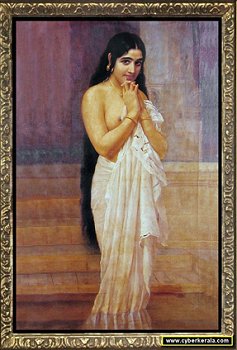
|  |

|  |
Of Raja Ravi Varma's nubile maidens and apsaras of dance - Shanta Serbjeet Singh, New Delhi e-mail: shanta.serbjeetsingh@gmail.com March 17, 2010  The apsara of dance in the caption above was, of course, Malavika Sarukkai.I went to the launch of her first dance DVD, "Vahini," a first for Times Music, too, at the Habitat, en route to the launch of art restorer and author, Rupika Chawla's magnum opus coffee table book on the Malayali prince. Malavika, draped in a diaphanous blue-green chanderi costume, redolent of Ravi Varma's use of gossamer clothing over the nubile form maidens, invoked the heavens itself in her powerful, moving and ever so lyrical depiction of the waters of life. When she finished, one said a silent hosanna of praise mixed with gratitude for witnessing, yet again, an apsara in motion. Unwilling to sit for the speeches that were to follow, I decided to move to Ravi Varma.Platitudes and speeches was not what one could accept after that baarish of rasa Malavika rained on the less than full Habitat auditorium. As I walked towards the exit, Sunil Kothari, India's 'only doctor of dance' as I like to call him, joined me for the drive to the Imperial Hotel where the Raja Ravi Varma book was to be launched. Now, the Imperial is, in every way, a story as grand and visually as majestic as that of the Malayali prince. As New Delhi's landmark hotel, built in 1931 by Bromfield, a Lutyens' associate, the hotel is known for its contemporary colonial style. Its location is itself unique, right in the heart of the shopping district of Connaught Place.A stately white building, it is approached by an avenue of 24 king palms, leading up to the porch, a witness to the very creation of New Delhi.Pillared verandas that you never see any more in space starved big cities, tea lounges, dining halls, a rolling green meadow for gatherings of the rich and powerful for buffets in Delhi's incomparable winters, above all the magnificent Royal Pavilion where the launch took place, is the setting for the Imperial. Vir Sanghvi seems to have missed its unique grandeur, perhaps because it is right under his nose! On way to the Imperial, Sunil said, apropos the Habitat audience, "That was Delhi's top crowd, no?" I replied, "Wait till we get to the Imperial. You will see Delhi's real power people there. And also the crème de la crème of high society." Sure enough, under the Imperial's majestic chandeliers, stepping daintily over thick pile carpets, the walls of the huge banquet hall lined by big Ravi Varma paintings (prints, I would think especially prepared from originals accessed by Rupika from a clutch of collectors), were the gorgeous Delhi ladies, dressed in the style of Ravi Varma's women.Heirloom silk saris, in red and green zari with black or gold blouses, a gold belt around the midriff, the men in velvet and zari embroidered coats and strings of pearls, it was a scene appropriately and deliciously decadent and out of a folio of Victorian India. Alongside the society chic were the power men and women. Rupika's husband is Navin, author of a definitive book on Mother Teresa. As the Chief Election Commissioner of India, and a thorough gentleman at heart, Navin is a connoisseur of art in his own right. Surveying the scene, both of us nibbling at choice canapes and twirling glasses of wine, Sunil looked at me wordlessly, finally finding his speech to say, "You were right!" Rupika's work breaks fresh ground by not just cataloguing, analysing and contextually placing Varma's works in the social milieu of the late 19th century but also by tracing the influences which may have shaped his artistic choices from the works of European masters of the time, artists like Rubin and Matisse. She researches long and hard and goes a step still further - tracing the way Varma's 'wet' look was copied by Raj Kapoor in films like 'Ram Teri Ganga Maili.' Whatever the aesthetic content of Raja Ravi Varma, it was certainly one evening when the past and present of Indian art and Indian contemporary society came together, hand in hand!  Shanta Serbjeet Singh, for twenty-five years, columnist, critic and media analyst for The Hindustan Times, The Economic Times and The Times of India, is the recipient of the Lifetime Achievement Award of the Sangeet Natak Akademi and Delhi Govt.'s Sahitya Kala Parishad for her contribution to the field of culture. She just finished her term as Vice Chairman of the SNA, is the founder-secretary of the World Culture Forum and continues as Chair of the UNESCO created NGO APPAN (The Asia-Pacific Performing Arts Network), a position to which she was appointed in 2001. Singh has authored several well-known publications such as 'Indian Dance: The Ultimate Metaphor' (published by Ravi Kumar (Paris), 'The 50th Milestone: A Feminine Critique' (Sterling Publishers, to mark India's fiftieth anniversary of Independence), 'Nanak, The Guru' (Oxford University Press) and 'America and You' (22 editions). |